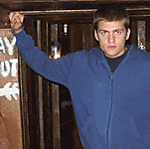I made a lot of progress today, completing all the major construction almost by accident since I hadn't intended to get quite this far along.
Step 16 presents an option between two different types/styles of exhaust configuration. For "Marne" the correct type are the fish-tail straight exhausts with the longer protective shrouds, so I used parts A26 and A11 to construct mine. The exhausts have a fine seam line that was a little tricky to remove but no other difficulties were encountered.

Step 17 directs you to install the mufflers onto the rear deck, which is easily accomplished since there are locator holes in both fenders to insure a squared-up fit. The protective guard rail, B33 is also installed and this part requires some cleanup since all the posts/rail sections have a mold seam and the joints where the posts meet the top rail also have sink marks that need to be dealt with. Last but not least, the concertina antenna support is constructed from two part halves. This design produces a join seam that has to be trimmed/sanded down without damaging the ridges on the flexible housing, I cleaned mine up using the back edge of a #11 blade for the interior surfaces and a fine grit sanding twig for the ridges themselves. I also installed the antenna wire leading into and out of the protective guard housing. The wire is just that, steel wire, that I bent to shape and glued in place with CA. The tip where it meets up with the antenna base was filed down with a square needle file and the antenna base is dryfit for now and will be removed for separate painting later.
I also didn't realize until writing this up that I neglected to install part B6 over the access door on the rear engine deck, fortunately it's not too late to still do that!

Edit: Correction done for part B6 installed.

Step 18 deals with the pioneer tools and the tow chain. The pioneer tools consist of a crowbar, sledgehammer, pick, and shovel that install together as a package of tools. The crowbar and pick are on the bottom with the sledge and shovel on top. The fit is very complex and I gave up trying to dryfit it, everything looks like it ought to fit properly so I'm not too worried about it and will install them later after painting is done.
I installed the rear hull tow swivels and did as the instructions directed by cutting the hook portion on each to accept the chain later on when that gets installed.

Step 19 begins the work on the turret by way of constructing the 47mm gun and mount along with the commander's cupola. The Lion Marc barrel requres that the one-piece Tamiya gun part A12 be trimmed down to the two mounting pins and a hole drilled out to accept the aluminum barrel. Tamiya provides 2 barrels since it's an A-sprue part, so I wasn't too worried about doing this surgery and not having a "plan B" if needed. It wasn't needed and the gun installed fairly easily, the barrel end did require a little bit of clean-up with a needle file but nothing serious.

The commander's cupola is a two-part affair, which means that the join seam that goes right across the top in the middle needs attention. I used some liquid glue to get as tight a join as possible and then came along behind that and sanded the join down. I also chose to position the armored visor cover in the open position although the darn thing kept wanting to slip down into a semi-closed position until it set up...so I had to keep the handling to a minimum.

Step 20 constructs the turret and also presents the option to have the large rear hatch open or closed. There's zero interior provided so since I wasn't planning on doing the included figure, I chose the closed hatch option. While the instructions seem to indicate that you should install the hatch part C4 before you join the turret top to the bottom, I decided to join the turret halves first and then install the hatch later. The two parts have a good fit but this join also requires some sanding to get it to look even. The Char Francais site indicates that there's a weld seam or a casting line around the base of the turret, however when I checked the photos on "Marne", I didn't see any evidence of this so kept the look smooth. The 47mm and coaxial machine gun mantlets were also installed as separate pieces and took a little bit of fiddling with to get them to sit properly since the gun mount has some play in its installation due to it being elevatable with the polycap mount from the previous step.

The final step is Step 21, it calls for the installation of the turret and the two smoke candles that are to go on either side on the fenders. The candles needed some cleanup due to the fact that their curved end faces are not molded flat, so a large seam/shift line is evident and needs to be taken care of.

That's it for major construction, it's now ready (once I install that part from the step I missed!) for painting.
Building this one was a lot of fun, and I got done in 4 hours what I usually futz around doing in a couple of weeks...




































































